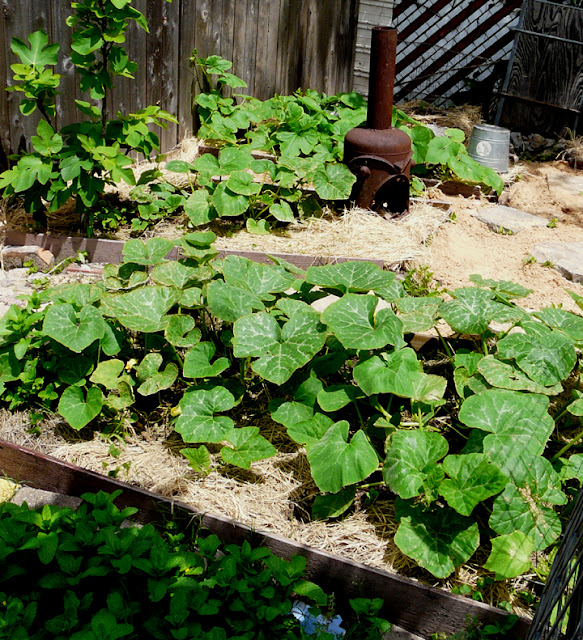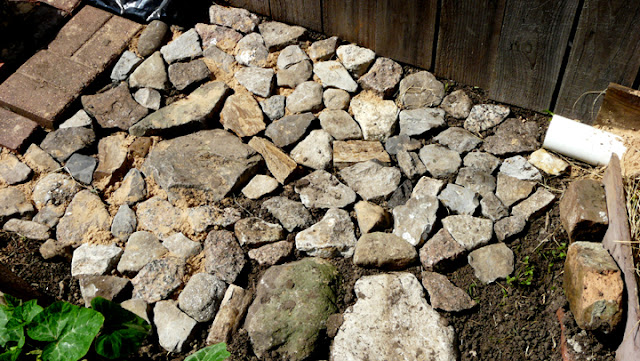It is that exciting time of year when hope springs eternal because it is spring. The weather is mild and still cool. We had a recent series of rain showers. The mosquitoes have yet to make an appearance. There could not be a more wonderful and more 'waiting for the shoe to drop' time of year than this. It is great, but it won't last.
Instead of dwelling on the upcoming horror that is the summer I am keeping my sights on the current moment and reveling in the garden. This year's garden is the best yet. I can't wait to introduce you to the starting line up.
If you have been following this blog from last year, you may recall how we spent a lot of time and effort transforming our ceder fence garden from several six foot by six foot beds into three foot by six foot beds. We also installed a water line down the back of each bed and installed drip hoses into each of ten beds. Whew! What an effort, but at least we won't have to redo the beds again since we got them so perfect...
 |
| The briefly perfect 2012 garden.. |
Ha ha! Oh how naive I was to think that. No, actually our perfect beds were not so perfect after all and this year we fixed them. Last year we had each bed surrounded by a back pathway, a front pathway and a pathway in between each bed. Each of these paths were about 22 inches wide. Why 22 inches? Because that was all the room I felt we would need to navigate and quite frankly was all the room I begrudgingly wanted to give up for something 'unnecessary' like a path. A path... pfft. You know, the thing you will walk down when your arms are loaded with harvest. That walkway you will travel countless numbers of times as you attend to the gardens needs. The thoroughfare that will become so choked with vines and abundant growth you will think malevolent thoughts of vegi-icide just so you can make your way through without tripping for the four billionth time.
 |
| Hmmm... I know there was a pathway around her somewhere... |
So it turned out that 22 inches was not nearly enough room, especially between the beds and the ceder fence. Heck, my shoulder width is 22 inches so each walk down that path meant rubbing up against the ceder fence (there was also this remnant of a fence post that was strategically placed in nearly the center of that 22 inch pathway. A post that we were going to remove but never got around to. A post that was about thigh high, the exact height which can be measured by the scars of where I rammed into it on at least half a dozen occasions leaving wounds and many more torn pants, torn shirts and narrow misses. God how I hated that inanimate object by the end of last year...).
The front pathway of last years beds became lost in a vegetable haze of overgrowth from the garden beds met by Bermuda grass from the lawn. Walking that path meant sliding along the dog fence and hippity hopping over vines, plants and tall weeds. Some places you would just have to detour up an in-between path to the back path before you could proceed up the front of the garden again. Definitely a cartoon map of Billy's path from Family Circus if ever drawn out.
 |
| This is a fairly accurate image map of a day in the life from my garden last year... |
My husband first suggested we widen the ceder fence path. My first response was 'but, but, nooooooo!' followed by the quick recognition of his wisdom. We could just take out the useless front path and move the beds forward to butt up against the dog fence. Not only would this give us a wider back pathway, but also add several inches onto the bed length. All it meant was digging out the front path, removing soil from the back of the bed and reframing each bed. Hard, relentless labor? Sign me up!
It was awful but in a mercifully limited way. The Bermuda grass covering the front path was tenacious and difficult to get rid of. There were thick cement blocks, about half a dozen, sunk into the ground and hard to remove. Along several sections I had created a rock pathway, which was totally overgrown with grass. Not only did we have to move the dirt from the back of the garden, but also pull up the water system we had so diligently installed last year.
On top of all of this work, we decided that the ceder fence path should be paved. No more of this unsteady footing, muddy walk and treachery. We were going to put down plastic to block the weeds and brick in that pathway. Piece of cake!
What a back breaking cake that was. But it is done. Many weeks of labor later it is done, all except cementing in the bricks (check in next year when I lament my decision to cement the path and am chipping through the bricks for some yet unfathomable reason). Last year I calculated that I must have moved a whales weight of dirt and stones in my gardening efforts. This year I am pretty sure I moved that whale again.
 |
| Ah yes. Moby Dirt. |
So we now are living the 2013 Spring Gardening Nirvana. Here is what is different this year:
The ceder fence pathway:
The back 40:
 |
| This was the last untamed land of our garden as it looked in 2012. Clumps of clay filled gumbo soil, tough roots, resilient weeds, and piles of rock were all that grew here. |
 |
| What a difference a ton of backbreaking labor can make! |
 |
| In addition to several new beds, this area also has strategically placed stepping stones to aid in squash vine navigation... |
 |
| and a drainage system to keep it from getting boggy. |
18 garden beds:
Sand:
 |
| Well, about 30 wheel barrow loads served to fill in some low spots and even out most of the back yard. This made no appreciable dent in the hulking sand pile in our front yard. |
A cooler spring:
Based on the photographic evidence from last year, our cool spring is having a dampening effect on our vegetable crop. We have not lost any plants due to freezing weather and most lows were in the 40s. We had several weeks where the temperatures did not rise above 70 degrees. I could see some minor leaf damage, but overall nothing seemed to be strongly effected. Then I took a look at my pictures and found some shocking comparisons. We planted at the same time last year, but by this time in 2012 I had already harvested my first crop of green beans. This year the first tiny little beans have just set. Last year the tomatoes were already bigger than my fist, but this year they are about golf ball sized so far. The butternut squash had a large sized fruit in April 2012. This year it is yet to start blooming. The worst effect seems to be on the okra plants. Leaf size last year at this time was triple the size of the leaves of the 2013 okra. The little plants look as if they have been in some sort of suspended animation.
The good news is that the plants are all doing very well and I am pretty sure they will catch up as soon as we have warmer night time temperatures. Don't get me wrong. I personally have been enjoying the cool weather and it has allowed me to do far more in the garden with far less personal suffering. It is interesting though how much difference there is in the plant growth.
Coming soon - an in depth look at this years garden participants.
Happy Gardening.







